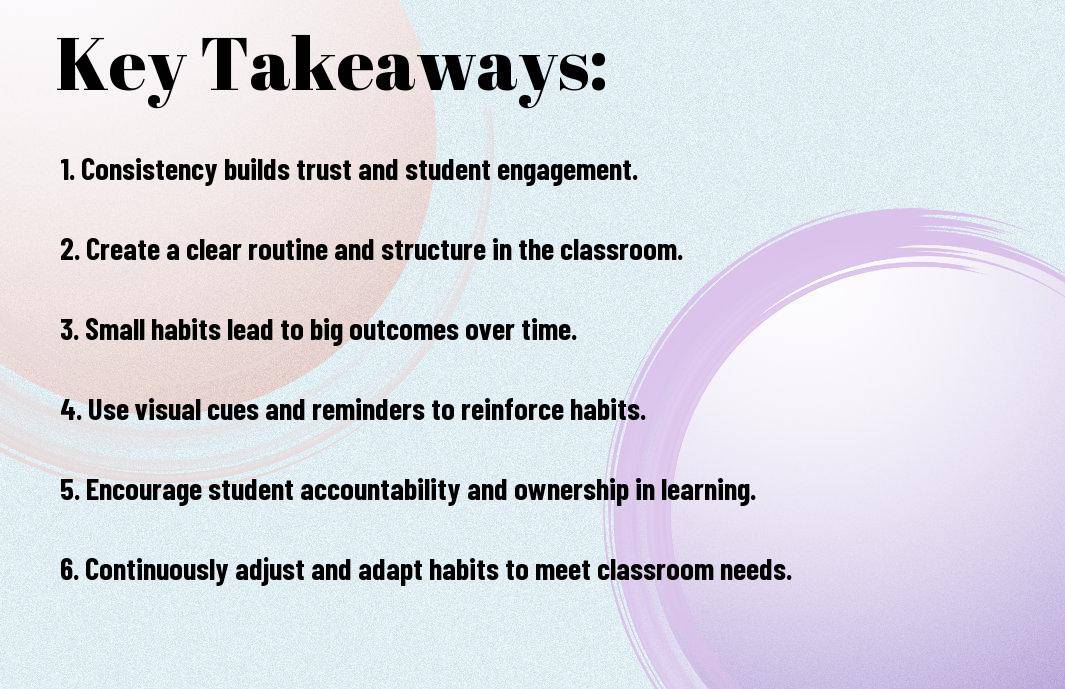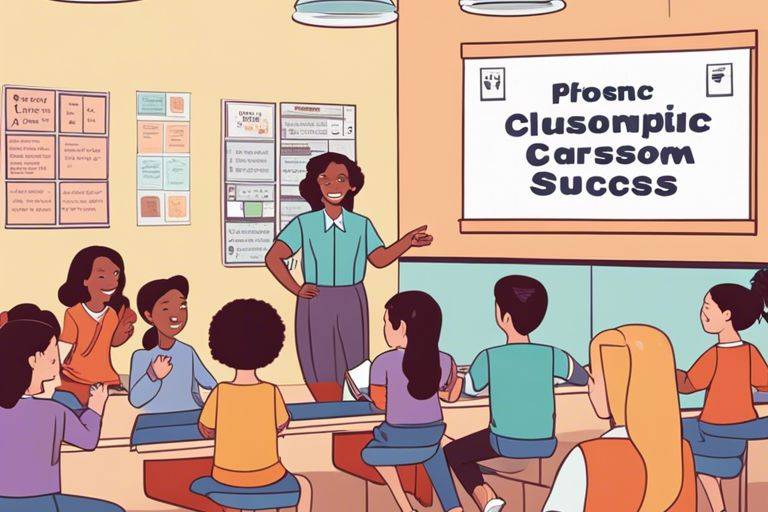Atomic Habits for teachers! It’s always a rewarding experience for teachers to see their students engaged and excited about learning. However, maintaining a high level of classroom engagement can be a challenging task. This is where the principles outlined in Atomic Habits Teacher Introduction can be incredibly valuable for educators looking to create a more interactive and dynamic learning environment.
By understanding how small changes and consistent habits can lead to significant improvements, teachers can foster a culture of active participation among students and create a more enriching educational experience for everyone involved. Let’s explore how teachers can apply the concepts of atomic habits to enhance classroom engagement and ultimately, inspire a love for learning in their students.
Key Takeaways:
- Consistency is key: Establishing consistent habits in the classroom can help foster engagement and routine for students.
- Start small: Encourage students to start small with their habits, focusing on achievable goals that can lead to bigger changes over time.
- Provide positive reinforcement: Recognize and reward students for their efforts in building positive classroom habits to reinforce behavior.
- Encourage reflection: Encourage students to reflect on their habits and how they contribute to their overall engagement and success in the classroom.
- Model good habits: Teachers should lead by example and demonstrate the habits they want to instill in their students.
- Build a supportive environment: Create a supportive classroom environment where students feel safe to try new habits and can seek help when needed.
- Consolidate habits with routines: Incorporate habits into daily routines to help students solidify new behaviors and make them a natural part of their school day.

Laying the Foundations: Preparing for Atomic Habit Implementation
Assuming you are ready to enhance your teaching practices and foster a more engaging classroom environment, delving into the world of Atomic habits could be the game-changer you have been looking for. Before jumping into implementing atomic habits in your classroom, it is vital to lay the groundwork for success.
Understanding Your Teaching Style
Any effective habit formation begins with self-awareness. Understanding your teaching style, your strengths, and areas for improvement is crucial. Reflect on how you currently engage with students, deliver lessons, and manage your classroom. Recognizing your preferences and tendencies will help tailor atomic habits to suit your unique teaching approach.
Setting Your Classroom Goals
Understanding the objectives you aim to achieve is fundamental in shaping your atomic habits. Identify what you aspire for your students to accomplish, whether it’s improved participation, enhanced critical thinking skills, or better classroom dynamics. By setting clear and specific classroom goals, you provide a roadmap for implementing atomic habits that align with your desired outcomes.
Plus, remember to keep your goals achievable, measurable, and relevant. This ensures that your efforts are focused and results-driven, guiding you towards creating a more engaging and productive learning environment for your students.
Atomic Habits: A Primer for Educators
Keep in mind that creating a positive and engaging classroom environment is not just about grand gestures; it’s about building small habits that lead to big changes over time. In his book “Atomic Habits,” author James Clear lays out a clear blueprint for how educators can implement small changes to optimize classroom engagement and student behavior.
The Four Laws of Behavior Change
One of the key concepts in “Atomic Habits” is the Four Laws of Behavior Change. These laws – make it obvious, make it attractive, make it easy, and make it satisfying – form the backbone of creating and sticking to new habits. By understanding and applying these laws, educators can effectively shape the behavior of their students in a positive way.
Making Habits Obvious and Attractive
Atomic habits are all about making small, incremental changes that have a big impact over time. In the context of the classroom, this could mean making subtle changes to the classroom environment that make desirable behaviors more obvious and attractive to students. By strategically placing visual cues or rewards, educators can guide students towards engaging in positive behaviors without much effort.
For instance, placing a visual reminder near the door reminding students to hang their coats can help make this habit more obvious. Additionally, implementing a system where students earn points for participation and can redeem them for rewards can make active engagement more attractive.
Customizing Your Habits for Enhanced Engagement
Your classroom habits play a crucial role in fostering student engagement. To optimize your habits, it’s beneficial to understand the concept of ‘Atomic Habits for Teachers and Students – Science Teaching.’ This insightful article provides valuable tips on how you can improve your teaching practices to create a more engaging learning environment. Check it out here.
Strategies for Making Habits Easy in the Classroom
Easy habits are fundamental in maintaining sustained engagement in the classroom. One effective strategy is to create a routine that simplifies tasks for both you and your students. By establishing clear expectations and procedures, you can streamline activities and minimize confusion. Additionally, organizing your classroom layout and materials in a structured manner can make it easier for students to navigate and participate actively in the learning process.
Techniques to Make Habits Satisfying for Students
With a focus on making habits satisfying, you can significantly enhance student engagement in your classroom. Incorporating elements of fun and creativity into your lessons can make learning more enjoyable for students. By offering rewards or incentives for active participation and achievement, you can create a positive reinforcement system that motivates students to stay engaged and strive for success.
Habits that are rewarding and enjoyable are more likely to be sustained over time, leading to enhanced classroom engagement and a more positive learning experience for both you and your students.

Building a Supportive Classroom Environment
Once again, fostering a supportive classroom environment is key to engaging students in their learning journey. When students feel supported and valued, they are more likely to participate actively and exhibit positive behaviors in the classroom.
Encouraging Peer Support
For effective peer support, encourage activities that promote collaboration and teamwork among students. Group projects, peer tutoring, and team-building exercises help students develop empathy and communication skills. Peer support can also boost confidence and motivation, as students feel a sense of belonging and connection with their classmates. By fostering a collaborative environment, you can create a positive peer support system that enhances overall classroom engagement.
Creating a Habits-Focused Classroom Culture
One way to build a habits-focused classroom culture is to establish consistent routines and expectations. By setting clear guidelines for behavior and academic responsibilities, students know what is expected of them and can develop positive habits over time. It’s important to model the behaviors you want to see in your students and provide consistent reinforcement for good habits. Celebrate small victories and milestones to encourage students to continue practicing positive behaviors.
It’s important to create a safe and inclusive environment where students feel comfortable taking risks and trying new habits. Encourage a growth mindset by emphasizing the importance of effort and perseverance in achieving success. By creating a habits-focused classroom culture, you can nurture a positive learning environment where students are motivated to engage and excel.
Overcoming Challenges and Staying Consistent
Many teachers face various challenges when it comes to fostering classroom engagement. From disruptive behaviors to personal obstacles, staying consistent in creating a positive learning environment can be tough. However, with the right mindset and strategies, teachers can overcome these hurdles and make a lasting impact on their students.
Identifying and Managing Disruptive Behaviors
Disruptive behaviors are common in classrooms and can hinder the learning experience for everyone. It is imperative for teachers to identify the root cause of such behaviors and address them promptly. Whether it’s a student seeking attention, dealing with personal issues, or lacking interest in the subject, taking a proactive approach can help redirect negative behaviors into positive ones. Setting clear expectations, establishing consequences, and offering support are effective ways to manage disruptive behaviors and create a harmonious classroom atmosphere.
Handling Personal Obstacles as a Teacher
On a personal level, teachers may encounter obstacles that impact their ability to engage with students effectively. With self-care and a support system in place, teachers can navigate through challenges such as burnout, stress, and lack of motivation. It’s crucial for educators to prioritize their well-being, seek professional development opportunities, and cultivate a positive mindset to overcome personal obstacles and maintain consistency in their teaching approach. By taking care of themselves, teachers can show up as their best selves in the classroom and inspire their students to do the same.
Measuring Progress and Celebrating Success
To create a supportive and engaged classroom environment, it’s necessary for teachers to measure the progress of their students’ habits and celebrate their successes. By tracking habits, educators can identify areas for improvement and provide positive reinforcement for students’ efforts.
Tools for Tracking Classroom Habits
With the advent of technology, there are various tools available to help teachers track classroom habits effectively. From digital habit trackers to simple spreadsheets, educators can choose the method that works best for them and their students. These tools can provide valuable insights into student behavior patterns, allowing teachers to make informed decisions about the direction of their teaching strategies.
Rewards and Recognition for Habit Milestones
Habits play a crucial role in shaping student behavior and attitudes in the classroom. By implementing a rewards system for habit milestones, teachers can further motivate their students to adopt positive habits and achieve their goals. Recognizing students’ efforts and progress can boost their confidence and self-esteem, leading to increased engagement and academic success.
Another important aspect of rewards and recognition is the element of surprise. By occasionally offering unexpected rewards for exceptional habit performance, teachers can create excitement and enthusiasm among their students, reinforcing the importance of consistency and perseverance in building good habits.
Adapting and Evolving with Your Classroom
Fine-Tuning Habits Throughout the School Year
Unlike a rigid system, the Atomic Habits approach allows teachers to fine-tune their habits throughout the school year. As you get to know your students better and understand what motivates them, you can adjust your habits to better suit their needs. Perhaps you find that a certain habit isn’t as effective as you initially thought or that a different approach could yield better results. By staying open to adaptation, you can create a dynamic and engaging learning environment for your students.
Being Flexible with the Atomic Habits Approach
With the Atomic Habits approach, flexibility is key when it comes to fostering classroom engagement. School environments are constantly changing, and what works one year may not work as well the next. Being able to pivot and adjust your habits based on the evolving needs of your students is crucial. Whether it’s incorporating new technologies, trying different teaching strategies, or adapting to unexpected challenges, flexibility allows you to cater to your students’ needs effectively.
School environments can be unpredictable, which is why being flexible with the Atomic Habits approach is necessary. Teachers must be willing to experiment, learn from their experiences, and adapt their habits accordingly to keep students engaged and motivated. By embracing flexibility and being open to change, educators can create a dynamic and responsive classroom that meets the ever-changing needs of their students.
FAQ
Q: What are atomic habits in the context of fostering classroom engagement?
A: Atomic habits are small, incremental changes that teachers can make to create a more engaging and dynamic classroom environment.
Q: Why are atomic habits important for teachers?
A: Atomic habits are important for teachers because they help create consistency, improve student engagement, and ultimately lead to better learning outcomes.
Q: How can teachers use atomic habits to foster classroom engagement?
A: Teachers can use atomic habits by implementing small changes such as greeting students at the door, incorporating interactive activities, and providing positive reinforcement.
Q: What are some examples of atomic habits for teachers to try?
A: Examples of atomic habits for teachers include establishing a daily routine, setting clear expectations, using positive language, and creating a welcoming classroom environment.
Q: How long does it take to form an atomic habit?
A: Forming an atomic habit can vary for each individual, but on average, it can take about 21 days to establish a new habit.
Q: How can teachers stay motivated to maintain atomic habits?
A: Teachers can stay motivated by tracking their progress, setting achievable goals, seeking support from colleagues, and celebrating small victories along the way.
Q: What are the benefits of using atomic habits to foster classroom engagement?
A: The benefits of using atomic habits include increased student participation, improved classroom dynamics, stronger teacher-student relationships, and a more positive learning environment.


